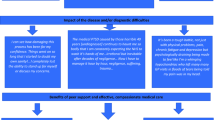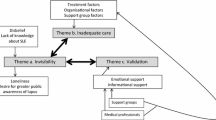Abstract
This is the first report from a qualitative research on lupus patients’ perspective expressed in the disease drawings. The aim of the study was to examine the variety of ways of illness perception and experiences among systemic lupus erythematosus (SLE) patients. The goal was also to assess the utility of drawing as an unconventional research method as well as a therapeutic means. Participants were 38 women with SLE. Patients attended ‘My life’ courses addressed to the lupus patients held in 2000–2002. During the psychological group sessions, subjects were asked to draw their disease and then to comment on their pictures. There were no time limits. The participants were ensured that their drawing abilities had no meaning. Despite initial hesitation, all of the patients drew their pictures. This report presents three lupus patients’ drawings. Analysis of disease pictures reveals that they are the priceless source of information on patients’ perspective and make many dimensions of living with the disease uncovered, especially psychological. This unconventional, nonverbal method allows patient to know and realize one’s emotions and feelings. From health professionals’ point of view, the advantage of drawing as a research method is the possibility of gaining much information that cannot be gained from interview or traditional tests alone. Drawing is a ‘good beginning’ to talk, it makes the patients open up to share their emotions, views, and experiences. Thus, it can be the useful therapeutic method. It can also prevent health professionals from schematization in approach to the patients with the same diagnosis.



Similar content being viewed by others
References
Wiginton KL (1999) Illness representations: mapping the experiences of lupus. Health Educ Behav 26:443–453
Büchi S, Sensky T, Sharpe L et al (1998) Graphic representation of illness: a novel method of measuring patients’ perception of the impact of illness. Psychother Psychosom 67:222–225
Goodman D, Morrisey S, Graham D et al (2005) Illness representations of systemic lupus erythematosus. Qual Health Res 15:606–619
Moses N, Wiggers J, Nicholas C et al (2005) Prevalence and correlates of perceived unmet needs of people with systemic lupus erythematosus. Pat Educ Couns 57:30–38
Stoll T, Sutclife N, Klaghofer R et al (2000) Do present damage and health perception in patients with systemic lupus erythematosus predict extent of future damage?: a prospective study. Ann Rheum Dis 59:832–835
Sharloo M, Kaptein AA, Weinman JA et al (1999) Predicting functional status in patients with rheumatoid arthritis. J Rheumatol 26:1686–1693
Broadbent E, Petrie KJ, Ellis CJ et al (2004) A picture of health—myocardial infarction patients’ drawings of their hearts and subsequent disability. A longitudinal study. J Psychosom Res 57:583–587
Moss-Morris R, Weinman J, Petrie KJ et al (2002) Revised illness perception questionnaire (IPQ-R). Psychol Health 17:1–6
Khan MA (2001) My self-portrait. Clin Rheumatol 20:1–2
Guillemin M (2004) Understanding illness: using drawings as a research method. Qual Health Res 14:272–289
Salmon PL (1993) Viewing the client’s world through drawings. J Holist Nurs 11:21–41
Nowicka-Sauer K, Koseda-Dragan M, Hebanowski M (2001) Psychological support and education as the main aspects of systemic lupus erythematosus “My life” programme. Ann Rheum Dis 60(Suppl 1):30 (abstract)
Isenberg DA, Horsfall AC (1993) Systemic lupus erythematosus—adult onset. In: Maddison PJ, Isenberg DA, Woo P, Glass DN (eds) Oxford handbook of rheumatology. Oxford Medical Publications, Oxford, pp 733–755
Hale ED, Treharne GJ, Lyons AC et al (2006) “Joining the dots” for patients with systemic lupus erythematosus: personal perspectives of health care from a qualitative study. Ann Rheum Dis 65:585–589
Acknowledgment
I am grateful to all the lupus patients attending our lupus course meetings. Their experiences and views are the source of priceless knowledge.
Author information
Authors and Affiliations
Corresponding author
Rights and permissions
About this article
Cite this article
Nowicka-Sauer, K. Patients’ perspective: lupus in patients’ drawings. Clin Rheumatol 26, 1523–1525 (2007). https://doi.org/10.1007/s10067-007-0619-9
Received:
Revised:
Accepted:
Published:
Issue Date:
DOI: https://doi.org/10.1007/s10067-007-0619-9




